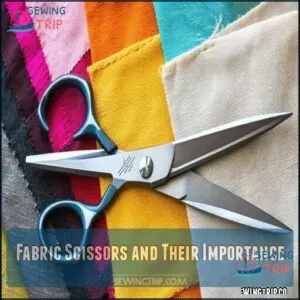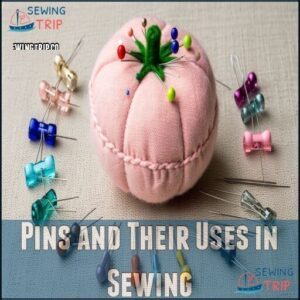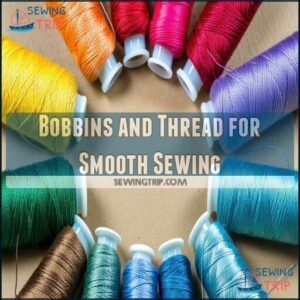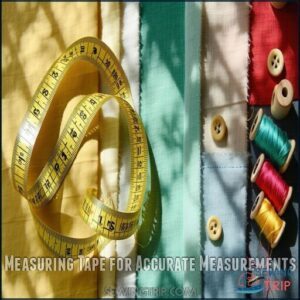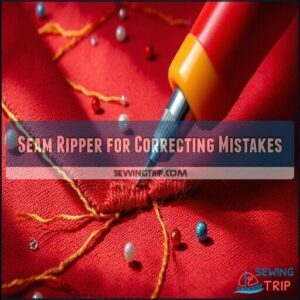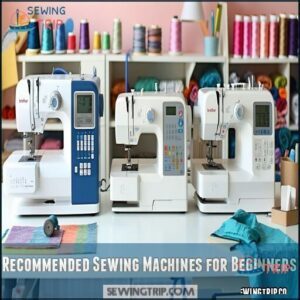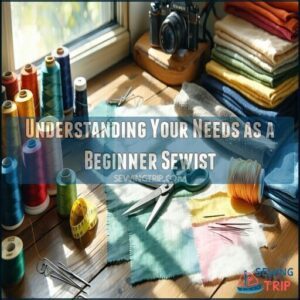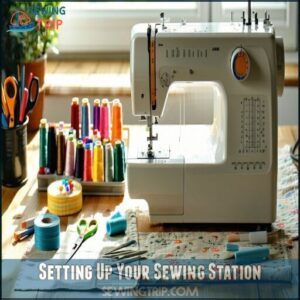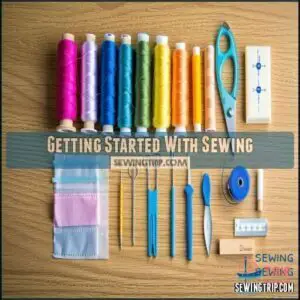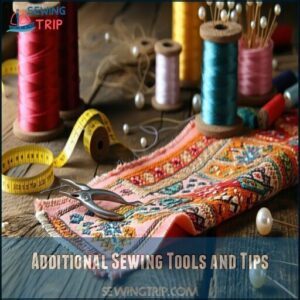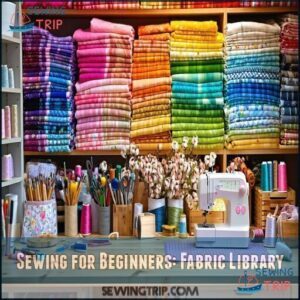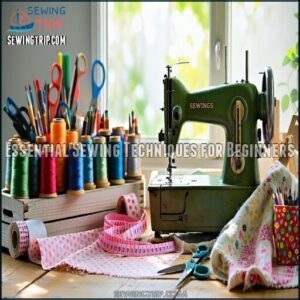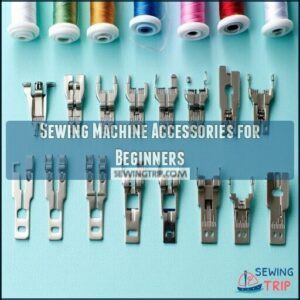This site is supported by our readers. We may earn a commission, at no cost to you, if you purchase through links.
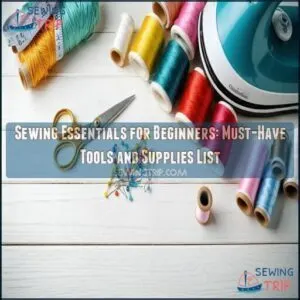 Starting with sewing? Gather these essential tools to make life easier and projects smoother. You’ll need sharp fabric scissors for clean cuts, a measuring tape for accuracy, and straight pins to hold pieces together—because fabric has a mind of its own.
Starting with sewing? Gather these essential tools to make life easier and projects smoother. You’ll need sharp fabric scissors for clean cuts, a measuring tape for accuracy, and straight pins to hold pieces together—because fabric has a mind of its own.
Don’t skip on thread and a few extra bobbins; running out mid-seam is no fun. A seam ripper is your best friend when mistakes happen (and trust me, they will).
Add a simple sewing machine, marking pens, and an iron for crisp edges. Ready to stitch up a storm? Stay tuned for more tips on setting up the perfect sewing station.
Table Of Contents
- Key Takeaways
- Essential Sewing Tools for Beginners
- Choosing The Right Sewing Machine
- Setting Up Your Sewing Station
- Basic Sewing Supplies for Beginners
- Getting Started With Sewing
- Additional Sewing Tools and Tips
- Sewing for Beginners: Fabric Library
- Essential Sewing Techniques for Beginners
- Sewing Machine Accessories for Beginners
- Frequently Asked Questions (FAQs)
- Conclusion
Key Takeaways
- Keep a well-stocked kit with basics like fabric scissors, measuring tape, pins, thread, needles, and a seam ripper to handle mistakes.
- Invest in a reliable sewing machine and choose lightweight beginner-friendly fabrics like cotton to make your first projects easier.
- Practice essential skills like stitching straight lines and using marking tools to ensure accuracy and improve results.
- Organize your sewing space smartly with labeled containers and an ironing station for a smoother, frustration-free workflow.
Essential Sewing Tools for Beginners
When you’re just starting out with sewing, having the right tools can make all the difference.
From fabric scissors to seam rippers, these essentials help you stay accurate, organized, and frustration-free.
These tools are crucial for a smooth sewing experience.
Fabric Scissors and Their Importance
When you’re sewing, fabric scissors are a game changer.
These dedicated tools deliver clean cuts, unlike regular scissors that struggle with fabric.
To make the most of your sewing scissors:
- Choose quality fabric shears with sharp blades to slice through any fabric type.
- Opt for ergonomic handles to prevent hand fatigue during long projects.
- Reserve them for fabric only—no paper or crafts!
- Keep them sharp by storing properly and checking blade maintenance regularly.
For cutting multiple layers, consider using quilting shears.
Pins and Their Uses in Sewing
Pins are your trusty helpers in the context of fabric holding. For sewing beginners, sewing pins are part of the must-have sewing essentials. Straight pins keep your fabric layers in place, especially around curves and tricky seams.
A classic pin cushion—like the iconic tomato—is perfect for storing them safely.
Here’s a guide to pin types and their uses:
| Pin Type | Best For | Features |
|---|---|---|
| Glass-Head Pins | Pressing seams | Heat-resistant |
| Ball-Point Pins | Stretchy fabrics | Prevents snagging |
| Quilting Pins | Thick layers | Extra sharp and long |
| T-Pins | Heavy fabrics | Strong holding power |
| Silk Pins | Delicate fabrics | Ultra-fine, prevents holes |
For pin alternatives, sewing clips work wonders, avoiding unnecessary holes in delicate fabrics. Find various options for these pins. Keep your tools handy, and embrace the tiny tailors at your side!
Bobbins and Thread for Smooth Sewing
Having the right bobbins and thread guarantees smooth stitching and keeps your sewing projects frustration-free.
Thread types matter—match them to your fabric weight for the best results. Proper bobbin tension and winding are your secret weapons for clean, even stitches. For a wider variety, you can explore thread options online.
- Pick thread types that complement your fabric weight and sewing machine.
- Wind bobbins evenly—avoid loose or uneven thread.
- Stock extra pre-wound bobbins for quick swaps.
- Organize thread spools by color for less hassle.
- Check your bobbin size—it must fit your sewing machine perfectly.
Smooth stitching starts here!
Measuring Tape for Accurate Measurements
How can you guarantee your sewing projects look polished and fit perfectly? It starts with an accurate measuring tape, a tool every sewing kit needs.
Whether you’re taking body measurements or estimating fabric for a project, the right tape makes all the difference. Flexible tapes handle curved surfaces like hems and sleeves effortlessly, something rigid rulers just can’t tackle. A good choice will be essential for sewing.
- Tape accuracy guarantees seams align and garments fit like a glove.
- Perfect for body measurements and tricky curved surfaces.
- Prevents costly fabric errors during fabric estimation.
- Reduces fitting issues caused by even small measurement mistakes.
Always double-check your measurements—measure twice, cut once! Your sewing essentials start here.
Seam Ripper for Correcting Mistakes
Mistakes in sewing happen, but a seam ripper is your trusty fix-it tool. With its curved point and tiny blade, it slides under stitches to cut them cleanly.
A seam ripper saves the day, turning stitching mistakes into quick fixes with ease and precision—your ultimate sewing rescue tool.
Be it crooked seams or tangled thread, this lifesaver prevents fabric damage when used carefully. Explore different seam ripper types to find one that fits comfortably in your hand.
For safe ripping techniques, focus on good light and work slowly. No seam ripper? Small scissors can work, but they’re trickier.
Every beginner sewing kit needs one—it’s an essential for repairing mistakes and mastering the art of sewing for beginners!
Choosing The Right Sewing Machine
Picking the right sewing machine can feel overwhelming, but it doesn’t have to be.
Focus on features like ease of use and durability to find one that suits your needs as a beginner.
Factors to Consider When Buying a Sewing Machine
You’ve got your tools; now it’s time to choose your sewing machine.
Start by thinking about your projects and what features you’ll really use. Keep it simple—beginners don’t need all the bells and whistles.
- Mechanical machines are great for straightforward repairs.
- Computerized models offer fancy stitches if you’ve got ambitious plans.
- Weight and size matter, especially if you’re tight on space.
Stick to your budget, but don’t settle for unreliable brands. A durable, user-friendly machine builds confidence and lasts for years. Buying wisely saves headaches and keeps the creative juices flowing!
Recommended Sewing Machines for Beginners
When picking a sewing machine for beginners, simplicity, durability, and value matter most.
The Brother CS7000X stands out with 70 stitches, an LCD display, and smooth automatic threading—perfect for exploring creative stitches.
Looking to sew thicker fabrics like denim? The Brother ST371HD offers heavy-duty needles and sturdy construction.
For a “less is more” approach, the Brother XM2701 provides essential features at a wallet-friendly price.
Budget considerations? Expect quality options ranging from $150-300, with user-friendly designs that make sewing less intimidating.
With thoughtful machine features and proper maintenance tips, these sewing machine recommendations deliver a solid foundation for any beginner sewing journey.
Understanding Your Needs as a Beginner Sewist
Before diving into beginner sewing, think about what truly suits your needs.
Ask yourself:
- Project Goals: Do you want to repair clothes, tackle home décor, or explore quilting?
- Skill Level and Time Commitment: How much can you practice sewing basics each week?
- Budget Allocation: What can you afford for a sewing kit or beginner sewing supplies?
Don’t worry about fancy gadgets yet.
Focus on sewing essentials that match your learning style and goals, so starting feels doable, not overwhelming.
Investing in a Quality Sewing Machine
Choosing the right sewing machine is a game-changer—it sets the stage for smooth stitches and long-term sewing success.
Avoid cheap, flimsy machines that stall your progress. Instead, invest in a quality model suited for beginners, guaranteeing reliability and ease of use.
Features like adjustable stitch length and built-in buttonholes make all the difference. Stick with well-known brands like Brother, Singer, or Janome, prized for their durability and great stitch quality.
Prioritize motor power and ease of maintenance for a longer machine lifespan.
- Budget Tip: Expect around $150-$300 for a solid beginner model.
- Key Features: Prioritize stitch variety and adjustable settings.
- Reputation Matters: Trust established sewing machine brands.
- Warranty Wins: A 1-year warranty adds peace of mind.
- Feature Importance: Guarantee effortless operation and part access.
Setting Up Your Sewing Station
When setting up your sewing station, organize your tools so everything’s easy to find, from scissors to thread.
A clean, well-lit space with a sturdy table will make sewing more enjoyable and hassle-free.
Importance of a Well-Equipped Sewing Station
An organized sewing station keeps your projects flowing smoothly and frustration-free. Create an ergonomic setup for comfort and focus by placing your machine at elbow height and ensuring good lighting.
- Efficient Workflow: Keep sewing tools like scissors and pins in labeled containers, always within reach.
- Organized Storage: Fold fabrics neatly in bins to avoid wrinkles.
- Safety Practices: Tidy spaces prevent accidents and fuel creative inspiration.
Essential Items for a Sewing Kit
A well-stocked sewing kit keeps your projects running smoothly—no mid-stitch scrambles for forgotten items.
Start with these beginner sewing supplies for stress-free creations.
| Item | Purpose | Pro Tip |
|---|---|---|
| Fabric Scissors | Precise fabric cuts | Keep them fabric-only! |
| Needle Variety | Handy for different fabrics | Arrange by size or type. |
| Thread Colors | Matches fabric seamlessly | Black and white first. |
Add marking tools for crisp patterns, a portable iron for neat edges, and pins or clips to hold fabric securely.
Pre-packed sewing kits bundle sewing tools, notions, and organizers, saving beginners time.
Invest in quality—it’s worth it!
Recommended Sewing Essentials for Beginners
Getting started with beginner sewing is easier when your sewing kit has the right essentials.
These tools don’t just help, they’re game-changers for creating projects smoothly.
- Fabric scissors: Keep them sharp and only for fabric—no paper!
- Thread basics: Black, white, and beige cover most projects.
- Measuring tape: Flexible and accurate for patterns or resizing.
- Hand sewing needles: A set with assorted sizes works for repairs or details.
- Pins with pin cushion: Keep fabric pieces secure for precision sewing.
Focus on budget essentials, consider space limitations, and choose tools based on your skill level and project needs.
Challenges of Starting Without Proper Tools
Starting without the right sewing tools can make beginner sewing feel like an uphill battle.
Skipping sewing basics often means frustration levels skyrocket, with simple tasks feeling far harder than they should.
Here are the common struggles you’ll face:
- Uneven stitches and crooked seams – Without quality sewing tools, your projects may not reach the desired quality.
- Safety risks and finger pricks – Sewing without proper pins or thimbles risks unnecessary injuries.
- Wasted resources, like fabric – Fixable errors become irreversible without a seam ripper.
- A steeper learning curve – A lack of key supplies makes sewing projects for beginners stressful instead of fun.
Having proper sewing supplies lowers obstacles and boosts confidence.
Beginners especially benefit from using essential hand-sewing tools to simplify the learning process.
Basic Sewing Supplies for Beginners
Starting your sewing journey is easier with the right tools by your side. From thread to fabric marking pens, these essentials make every stitch smoother and more enjoyable.
Thread and Its Uses in Sewing
Your sewing projects rely on the right thread to hold everything together. Begin with all-purpose polyester—it handles most fabrics like a champ. If you’re working with natural materials, reach for cotton thread for a perfect match.
To choose the best sewing machine thread, think about:
- Thread types: Match polyester with synthetics and cotton with lighter fabrics.
- Thread weight: Thinner threads for delicate projects, thicker for heavy-duty.
- Matching thread: Select colors that blend or contrast artfully.
Check thread tension often to prevent puckering, and take care of your spools by keeping them away from sunlight.
Fabric Marking Pens or Pencils for Accurate Measurements
Marking tools are like your sewing GPS—they guide your cuts and stitches. Without them, you’re guessing!
Fabric markers and pencils let you create accurate guidelines. Here are some beginner sewing options:
- Water-soluble markers: Wipe away with water, ideal for most fabrics.
- Air-erasable pens: Fade over time—great for quick projects.
- Tailor’s chalk: A classic choice, perfect for precise lines.
- Tracing wheels: Transfer patterns effortlessly onto fabric.
Pick a marking tool based on fabric compatibility and fast removal. Bright colors help visibility, but test to confirm they don’t stain!
Iron and Ironing Board for Crisp Edges
Although often overlooked, an iron and ironing board are key players in sewing for beginners, transforming fabric into polished creations.
Whether you’re Seam Pressing or attaching Fabric Interfacing, good Ironing Techniques can elevate your projects. A sturdy ironing board with padding and a steam iron with adjustable settings makes all the difference. Portable Irons are also handy for small spaces.
| Tool | Purpose |
|---|---|
| Steam Iron | Smooths fabric, removes wrinkles |
| Ironing Board | Provides a supportive pressing surface |
| Portable Irons | Great for tight spaces or travel |
| Iron Maintenance | Guarantees peak iron performance |
| Seam Pressing | Creates polished seams and hems |
Cutting Mat for Safe Fabric Cutting
Protecting your work surface while cutting fabric is as important as pressing those crisp seams. A self-healing cutting mat makes fabric cutting safer and smoother, especially with a rotary cutter.
It keeps your cutting tools sharp and your table nick-free. Grid lines on the mat boost accuracy, making straight, even cuts a breeze.
- Prolongs rotary cutter blade life
- Shields surfaces from accidental damage
- Improves precision with printed grids
- Provides a stable, smooth cutting surface
- Store flat; warped mats are trouble!
Getting Started With Sewing
Starting with sewing might seem tricky at first, but it’s easier than you think with the right tools and some patience.
Focus on mastering basic skills, like threading a needle and sewing a straight line, to build confidence and keep things fun.
Hand Sewing Needles for Finishing Touches
A trusty set of hand sewing needles is like the Swiss Army knife of sewing supplies—it’s perfect for those finishing touches machines just can’t handle.
Whether you’re hemming pants, attaching buttons, or tackling repair projects, hand sewing needles have got your back.
Different needle types serve specific purposes: sharps for all-purpose sewing, ballpoints for stretchy knits, and betweens for intricate quilting.
Grab a needle threader—it’s a small gadget that’ll keep your eyesight (and sanity) intact when threading those tiny eyes.
Store your needles in a pincushion or case to avoid surprises (like stepping on one).
And remember, mastering threading techniques and stitch selection is key for pro-level hand sewing.
- Pro Tip: Always match needle size to fabric thickness.
Benefits of Learning to Sew
Sewing offers more than stitches—it’s a gateway to creative expression and practical skills that improve your daily life.
Sewing unlocks creativity and equips you with practical skills, transforming everyday tasks into thrilling opportunities for personal expression.
With sewing for beginners, you’ll master the art of customization, from altering clothes to creating unique pieces that fit your style.
It’s also a step toward sustainable fashion, letting you repair instead of replace your wardrobe.
Beyond practicality, sewing is a stress reliever.
The rhythm of threading needles or guiding fabric can quiet your mind, offering a welcome pause in today’s screen-filled world.
Every project strengthens your sewing skills for beginners, building patience and precision.
Sewing can also provide a significant boost in mood, fostering happiness and satisfaction through creative expression.
Joining a sewing community for beginners opens up endless sewing inspiration.
Whether mending a hem or crafting bold designs, this rewarding hobby connects you with a like-minded creative circle.
Project Inspiration for Beginners
Looking for sewing inspiration? Start with these easy projects perfect for beginners:
- Tote Bags – Practice straight stitches while crafting quick gifts or upcycling ideas.
- Pillow Covers – Add charm to your home decor with fun patterns.
- Simple Clothing Alterations – Hem pants or shorten sleeves for useful, personal sewing projects.
These beginner-friendly sewing ideas build confidence and spark creativity!
Importance of Practice in Sewing
Building your sewing skills takes consistent practice, and yes, mistakes are all part of the learning curve.
Think of each stitch as a small step toward mastering sewing fundamentals. Start with simple drills like stitching straight lines or practicing curves—these build muscle memory, essential for improving precision.
Tackling beginner projects—like pillowcases or tote bags—not only boosts your confidence but also helps you understand fabric handling and sewing techniques. Every small project is a chance to grow, adding skill development to your toolbelt.
Remember, even the pros sharpened their sewing fundamentals over time. Embrace the process, have fun with it, and soon, you’ll stitch smoother seams and tackle more complex designs with ease and pride!
Additional Sewing Tools and Tips
You’ll find that a few extra tools can make sewing easier, faster, and more fun.
From keeping your seams straight to snipping threads with precision, these handy tips and tools will take your projects up a notch.
Seam Measuring Gauge for Precise Seam Allowances
A seam gauge is every beginner’s go-to tool for achieving accurate and professional results.
Its compact design makes measuring seam widths, hem consistency, and fabric edges a breeze, whether you’re working with straight lines or curves.
- Gauge accuracy: Precise markings guarantee measurements are spot on every time.
- Effortless handling: Lightweight and easy to maneuver for various sewing projects.
- Versatile use: Perfect for hems, seam widths, and even spacing buttons.
Add this sewing essential to your toolbox for stress-free, consistent outcomes!
Sewers Aid for Preventing Fabric Sticking
Struggling with sticky fabrics like vinyl or rayon? Sewers Aid is your game-changer!
Just a tiny drop on your sewing machine needle, presser foot, or thread works wonders.
It cuts down on material drag, keeps tension smooth, and saves you time.
Compatible with most sewing supplies, it’s perfect for beginners battling tough fabrics.
Bonus: no messy residue! This simple lubricant will keep your projects frustration-free and your stitches as smooth as butter, making Sewers Aid a great tool for a game-changer.
Hera Tool/Marker for Marking Fabric
Tired of messy chalk or ink stains on your fabric? The Hera tool offers a fuss-free way to make clean creases without a trace left behind.
It’s a must-have in your sewing supplies, especially for delicate materials. Using controlled pressure, it creates visible impressions that act as guides for precise work like hems or folds—no smudges, no hassle.
Here are its standout benefits:
- Hera Tool Uses: Perfect for creasing instead of marking tricky fabrics.
- Marking Pressure Control: Gentle yet effective for sharp impressions.
- Alternative Marking Tools: Avoid chalk smudges with this sleek, low-maintenance option.
Every beginner sewing stash needs this handy tool!
Sharp Small Scissors for Snipping Threads
Sharp small scissors are essential for neat, precise thread snipping.
A pair with an ergonomic scissor design fits comfortably in your hand, making even intricate trims easy.
Always prioritize thread snip sharpness—dull blades can snag threads and ruin fabric.
Scissor maintenance tips like regular cleaning and sharpening will keep them in top shape. Check out the best scissor brands for long-lasting quality.
Remember, sewing tools like thread snips and fabric scissors simplify your sewing supplies arsenal.
Sewing for Beginners: Fabric Library
Building your own fabric library is like starting a treasure chest of creativity—each piece has its own purpose and potential.
Start with beginner-friendly fabrics like cotton, and explore textures and patterns as your skills grow, which can lead to a new level of creativity.
Natural Cottons and Silks for Versatile Projects
Cotton and silk are perfect fabrics for sewing beginners. Cotton’s durability makes it forgiving, while silk’s luxurious drape offers sophistication.
Exploring these options enhances your sewing projects and sparks creativity.
- Choose cotton for everyday use, thanks to its strength and versatility.
- Opt for silk blends for smoother handling and elegant results.
- Look into ethically sourced fabrics for sustainable choices.
- Experiment with fabric blends for customized project suitability.
- Test natural dyes to add personal flair and sustainable style.
Velvets and Jerseys for Luxurious Textures
Velvets and jerseys are fantastic for adding luxury and comfort to your sewing projects.
Velvet’s plush texture enhances jackets or pillows, but its pile direction means you’ll need care when cutting and stitching. Always use sharp fabric scissors, a sewing machine, and sewing needles designed for delicate fabrics for clean results.
Jerseys, known for their stretch factor and drape, are perfect for T-shirts, dresses, or leggings. Their flexibility makes them a great choice when experimenting with seam finishes or achieving a soft fit.
For beginners, these fabrics can be tricky, but with sewing tips like practicing your stitches and ensuring proper needle choice, you’ll achieve polished, professional results with ease.
Personalized Fabrics for Unique Creations
In the context of sewing for beginners, personalized fabrics let you add flair and creativity to your projects.
Whether you’re designing clothing or crafting home decor, imaginative fabrics make your work uniquely yours.
With tools like a sewing machine and sewing patterns, you can bring custom designs to life.
Explore these ideas to get started:
- Fabric Printing: Use digital design or Dye Sublimation for intricate, bold patterns.
- Custom Embroidery: Add details to make any project one-of-a-kind.
- Textile Painting: Personalize plain fabric with brushes and fabric-safe paints.
- DIY Dyeing: Experiment with tie-dye or ombré effects at home.
- Fabric Stamping: Craft repeating patterns with block stamps for handmade charm.
With these techniques, your sewing tools and creativity will work wonders!
Fabric Swatch Packs for Exploring Different Textures
Fabric swatch packs are a beginner’s best friend for exploring textures and making confident fabric choices.
They’re perfect for hands-on learning and testing your skills without wasting fabric. Plus, they boost your sewing confidence!
- Experiment with Texture Exploration to match projects.
- Identify fibers for better Project Suitability.
- Assess fabric weights like a pro.
- Use smaller pieces for practice runs.
- Check Pack Contents before purchasing.
Swatch packs are the ultimate beginner sewing supplies for smarter decisions!
Essential Sewing Techniques for Beginners
Learning a few basic sewing techniques will set you up for smoother, more enjoyable projects. From measuring fabric to fixing mistakes, these tips will save you time and frustration.
Measure Twice, Cut Once for Accurate Measurements
Accuracy isn’t optional when sewing—it’s your best friend.
Use measurement tools like a measuring tape, ruler, or seam gauge to get things right. Always double-check before cutting; it saves time, fabric, and frustration.
Cutting techniques matter too—pair precision tools with a cutting mat to protect your table and blades.
For pattern adjustments, fabric markers or tailor’s chalk help mark exactly where to cut or stitch. To get started, it’s best to take body measurements with minimal clothing.
Consistency in measuring guarantees proper seam allowance and polished results every time, which is why accuracy and precision are key.
Using a Thimble for Hand Sewing
Hand sewing? A thimble’s your secret weapon.
Protecting your finger from sneaky sewing needles makes stitching safer and smoother.
Here’s how to get it right:
- Thimble Materials: Metal adds durability, leather feels soft, silicone grips well.
- Thimble Sizing: Snug is better, ensuring control.
- Hand Protection: Wear it on the pushing finger.
- Sewing Comfort: Test it out—it’s a game-changer!
Keeping a Pack of Band-Aids Handy
While sewing can be fun, accidents happen, especially with sharp tools like needles and scissors. That’s why keeping a pack of Band-Aids in your kit is a no-brainer.
A quick fix can save your project—and your fingers—when small slips occur. Plus, prompt first aid prevents infection and lets you get back to stitching in no time.
- Bonus Tip: Choose flexible Band-Aid types that stay put, even while working.
Take this sewing advice for beginners seriously. It’s one of the simplest sewing safety tips to keep injuries minor and manageable.
Investing in Quality Sewing Tools
For a smooth sewing experience, choosing well-made sewing tools is key.
Quality matters—fabric scissors with sharp blades glide like butter, and a sturdy measuring tape guarantees accuracy every time.
Ergonomic designs, like comfortable scissors or handheld tools, can save your hands during long projects.
Investing in a reliable sewing machine with trusted brand reputation pays off in durability and smoother stitching. Though higher costs might seem intimidating, the tool longevity and material quality make it worth it.
Beginner sewing supplies should enhance, not hinder, your creativity!
Sewing Machine Accessories for Beginners
To get the most out of your sewing machine, you’ll need a few key accessories that make sewing easier and more precise.
From extra bobbins to presser feet, these tools are your best allies for tackling beginner projects with confidence.
Presser Feet for Various Sewing Tasks
Presser feet are game-changers among sewing machine tools, making tasks easier and your projects look professional.
These handy sewing machine accessories guide fabric smoothly, ensuring precise stitches every time.
Each foot has a job, and knowing them transforms your sewing adventures.
For instance:
- Zipper Feet: Perfect for stitching close to zippers or piping without breaking a sweat.
- Teflon Feet: Glide effortlessly over tricky fabrics like leather or vinyl.
- Gathering Foot: Creates ruffles effortlessly—think frilly curtains or playful dresses.
- Blind Hemming Feet: Achieve clean, invisible hems like magic.
Ensuring foot compatibility with your machine and adjusting pressures as needed keeps your sewing journey frustration-free.
Use these sewing machine essentials to discover your creativity!
Sewing Machine Needles for Different Fabrics
Choosing the right sewing machine needles makes all the difference.
Universal needles handle woven fabrics, while ballpoint needles gently work with knits.
For thicker or thinner fabric, match the needle size—like 80/12 for medium-weight materials.
Pair your thread with the needle type for smoother sewing. Change needles often to avoid skipped stitches or damage.
Your sewing machine will thank you!
Bobbins for Smooth Sewing
Mastering bobbins is key to trouble-free sewing, especially for beginners! These tiny spools control the balance of thread tension in your machine. With the right bobbin type—like Class 15 or L-style—you can avoid chaotic stitches.
Here’s how to handle them like a pro:
- Even thread winding prevents tangles and uneven stitches.
- Clean bobbin cases regularly to keep the machine running smoothly.
- Match thread weights for consistent bobbin tension.
Pro tip: Keep bobbins stored neatly to avoid spaghetti-like messes when inspiration hits!
Rotary Cutters for Precise Fabric Cutting
Rotary cutters are game-changing sewing tools, offering cleaner cuts than traditional scissors. Imagine slicing fabric smoothly—just like a pizza!
These cutting tools, when paired with trusty cutting mats, make the job neat, precise, and hassle-free.
Here’s how to make the most of your rotary cutter:
- Opt for the right blade: a 45mm works for most tasks, while 28mm handles curves and details.
- Use ergonomic handles to prevent hand fatigue during long projects.
- Follow safety measures: always slice away from your hand to avoid accidents.
- Cut on a mat to protect surfaces and keep blades sharp.
- Stick to maintenance tips, like replacing dull blades for smooth results.
With practice, this tool will feel like a sewing companion you can’t do without!
Join a Sewing Community for Support and Inspiration
Joining a sewing community connects you with like-minded sewists who share your passion.
It’s not just about camaraderie—these groups are packed with sewing inspiration for beginners.
You’ll explore Skill Sharing, Pattern Exchanges, and even Collaborative Projects.
| Activity | Benefit | Who It’s For |
|---|---|---|
| Project Showcases | See fresh ideas | Beginner sewists |
| Critique Constructively | Improve your techniques | All skill levels |
| Sewing Resources | Access tools and guides | Sewing education for beginners |
Start With Simple Projects for Building Confidence
The best way to build confidence as a beginner is by tackling easy sewing projects that make learning fun and rewarding.
Small projects help you practice basics, experiment with fabrics, and enjoy quick wins.
Start with these beginner-friendly ideas:
- Pillowcase Project: Soft cotton and straight stitches create cozy, stylish covers.
- Tote Bag: A practical starter project for learning pattern instructions and sturdy seams.
- Simple Garments: Basic shirts or skirts teach essential sewing techniques without overwhelming beginners.
Sewing tutorials for beginners can guide you step-by-step. These small projects let you learn to sew while creating something useful and personal!
Frequently Asked Questions (FAQs)
What does a beginner need to start sewing?
You’ll need basics like needles, thread, scissors, and measuring tape.
Add a sewing machine if possible, fabric, pins, and a seam ripper.
Don’t forget patience—it’s a key tool for every beginner!
What to buy as a beginner in sewing?
Starting sewing is like baking your first cake—begin simple.
Buy needles, thread, fabric scissors, pins, measuring tape, and a seam ripper.
Add fabric in cotton, a basic sewing machine, and bobbins to keep projects smooth.
What is basic sewing stuff?
You’ll want needles, thread, scissors, and a measuring tape.
Add fabric, pins, and a seam ripper—trust me, mistakes happen.
A small iron helps finish seams, and a sewing machine’s super useful if you can.
What should be in a beginners sewing kit?
Your beginner sewing kit should include needles, thread, fabric scissors, pins, a seam ripper, measuring tape, small scissors for trimming, tailor’s chalk, and a pin cushion.
Add a thimble for hand sewing and an iron for perfect seams.
Are there any sewing essentials for beginners?
A beginner sewing kit includes fabric scissors, needles, a seam ripper (your mistake fixer), thread in basic colors, and a measuring tape.
Add a pincushion, tailor’s chalk, and small scissors for details—you’re set with a complete beginner sewing kit.
What equipment do you need to learn to sew?
To learn sewing, grab a sewing machine, fabric scissors, thread, needles, measuring tape, pins, and a seam ripper.
Add fabric and an iron for practice.
A simple project will boost your confidence!
What do I need to start sewing?
Get started with needles, thread, scissors, and fabric—your sewing squad.
Add a measuring tape, pins, and a seam ripper for mistakes.
A sewing machine speeds things up, but start small and grow confidently.
Do you have a list of basic sewing tools for beginners?
Start with fabric scissors, needles, measuring tape, thread, pins, and a seam ripper.
Add an iron for pressing, marking tools for precision, and a small storage box.
These basics keep you sewing smoothly!
What sewing essentials do you need for a sewing machine?
You’ll need needles, bobbins, thread, a seam ripper, and scissors ready to go.
Add pins or clips for securing fabric, a measuring tape for accuracy, and oil to keep your machine humming along smoothly!
What are the essentials of sewing?
You might think sewing is overwhelming, but it’s not!
You’ll need fabric scissors, a measuring tape, thread, needles, pins, and a seam ripper.
A sewing machine speeds things up, but patience and practice matter most!
Conclusion
Mastering sewing essentials for beginners might feel like preparing for a sewing Olympics, but with the right tools, you’re set for success.
Start simple: sharp scissors, a trusty sewing machine, and a seam ripper for those inevitable “oops” moments.
Keep your sewing station organized, stocked with threads, pins, and marking tools.
Don’t forget to practice—it’s the thread that ties everything together.
Soon, you’ll stitch with confidence and create projects that truly impress!

